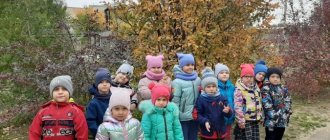Project “Broad Maslenitsa” for children of senior preschool age
Broad Maslenitsa project for children of senior and preparatory groups
The material is useful for preschool teachers: music directors, educators, primary school teachers, additional education teachers, after-school teachers. The material is intended for older children and primary school children. The project is used as an independent event, its elements are carried out in the NOD, in free time, as leisure or entertainment
Explanatory note This project is designed to fully immerse children, parents and preschool employees in the atmosphere of preparation and celebration of Maslenitsa Week. When developing the project, the requirements of the Federal State Educational Standard were taken into account. This project is built on the integration of all educational areas of the program. During the implementation of the project, both traditional forms of the process of raising, developing and teaching children, as well as modern ICT, health-saving technologies are used, special attention is paid to a person-oriented approach in communicating with children, and close cooperation with parents. Familiarization with folk traditions ensures the spiritual and moral development of the individual. The key role of preschool education is to create conditions for the formation of a harmonious, spiritually rich, physically healthy, developed personality with aesthetic consciousness, the makings of artistic culture, and creative abilities for individual self-expression through various forms of creative activity. In preschool age, deep feelings of love and affection for one’s culture, for one’s people, for one’s land are formed. Knowledge of the history of one’s people, native culture, participation in folk festivals spiritually enriches the child, fosters pride in one’s people, and maintains interest in their history and culture. How did people live? How did you work and how did you relax? What made them happy and what worried them? What traditions and customs did they observe? How did you decorate your home? How did you dress? What games did the children have? What holidays? To answer these and similar questions means to restore the connection of times, to return lost values. To do this, you need to turn to the sources of Russian folk culture, the history of Rus', come into contact with folk art and part of the child’s soul, the beginning that gives rise to personality. To instill in children pride in their people, to maintain interest in their history and culture, to help them to know and respect their past, their origins, the history and culture of their people. Project goal: To form an understanding of folk traditions in preschool children by immersing themselves in the atmosphere of the Maslenitsa holiday, to introduce children to the traditions and customs of the Russian people, to promote the overall development of children and the formation of the national culture of children and adults through nurturing love and developing interest in the present and past of their native land country, native land. Project objectives: Musical and didactic:
- to form the understanding of children and their parents about traditional Russian culture, to introduce the history and traditions of the Russian people using the example of the Maslenitsa holiday;
- introduce Russian folklore associated with the celebration of Maslenitsa (songs, chants, round dances, fairy tales, games) - introduce the traditional Russian way of life, traditional national clothing, handicrafts. — introduce dishes of traditional Russian cuisine, the history of the appearance of pancakes. Developmental:
- promote the development of interest in the history of the native country, customs and traditions in people’s lives, in ritual Russian holidays;
- develop search activities and creative activity; — develop interest in Russian folklore and the desire to take an active part in conducting thematic entertainment, leisure, and educational activities; - develop communication skills, develop the ability to help each other, communicate with each other, - form self-esteem of your actions, learn to evaluate the actions of other people kindly; — activate the creative potential of parents, attract them to active cooperation with preschool educational institutions. Educating:
- to cultivate moral and patriotic qualities based on knowledge of Russian traditions, pride in one’s people;
— to cultivate respect for the past and cultural and historical values of the Russian people, the desire to preserve and increase the wealth of their people; — to cultivate interest and love for Russian national folklore, emotional empathy and the desire to participate in the game-action. - cultivate friendly relationships between children, tolerance for the peculiarities of the national culture of each child; - to guide parents of pupils to introduce their children to their national culture in the family, to instill in their children respect and interest in the cultural and historical values of their home country and the cultural characteristics of other nations. Relevance of the project Modern society is characterized by the growth of national self-awareness, the desire to understand and learn the history and culture of its people. Issues of spiritual and moral education are a priority from the point of view of state policy in the field of education. The revival of Russia and the maintenance of its international status are connected today not only with the solution of political, economic, social problems, but, above all, with the education of a highly moral personality of a citizen of our Fatherland, the development of his spirituality, and the personal acceptance of historically established morality and ethics. Currently, the social and personal development of preschool children, the development of moral values, and concern for the emotional well-being of children have become relevant. Folk culture is one of the means of moral, cognitive and aesthetic development of children. Russian folk culture has a huge influence on the formation of a child’s spiritual world, the development of his intellect, emotions, and creative abilities. Russia is rich in its traditions, customs, and folk holidays. One of these holidays is the large folk festival at the end of winter, “Maslenitsa,” and direct participation in the holiday leaves a more complete and profound understanding of it, giving children the opportunity to understand the depth, breadth and profound meaning of this cheerful and slightly sad holiday.
The novelty of the project Contact with ancient Russian traditions contributes to the formation of deeper and more emotionally rich ideas of children and their parents about traditional Russian culture, and contributes to a more entertaining and productive acquaintance with the history and traditions of the Russian people. During the implementation of the project, both traditional forms of the process of raising, developing and teaching children, as well as modern ICT, health-saving technologies are used, special attention is paid to a person-oriented approach in communicating with children. Type of project: according to the number of children - group, different ages according to the dominant method - playful, creative; by educational areas - integrated (cognitive development, socio-communicative development, artistic and aesthetic development, speech development, physical development) by duration - short-term (03/09/2021 - 03/12/2021) Project support: - Scientific and methodological: selection of the necessary scientific- methodological literature, studying Internet resources, drawing up an entertainment script, consultations for parents, drawing up a plan for organizing and conducting a project, selecting audio recordings of folk songs and melodies, selecting a library with oral folk art, small folk genres of fiction of the Russian people, compiling a card index of folk games. — Logistics: audio system, television and video equipment, ICT; — Visual and didactic: works of decorative and applied art and folk items with various types of paintings, photographs, reproductions of paintings and illustrations, multimedia presentations, cartoons; — Subject-spatial development environment: assembly hall with the appropriate PPRS (music corner, physical education corner, PPRS for theatrical activities), mini-museum “Russian Izba”, “Mumming Corners” in group rooms, appropriate thematic design of book corners, iso-corners , corners of national culture, parental corners, design of the territory (hall) of the preschool educational institution. Forms of organization 1. Conversation, communication.
2. Games: didactic, plot, finger, round dance, moving. 3. Modeling. 4. Excursion. 5. Listening and learning folklore works. 6. Entertainment. 7. Viewing presentations and cartoons, examining reproductions of paintings, illustrations, household items and decorative arts. Stages of project implementation
1. Preparatory stage
• defining the goals and objectives of the project;
• selection and study of material, manuals, literature on the topic; • determination of the main directions of work on the project; • drawing up a plan for the main design stage; • selection and production of visual and didactic material; • creation of a subject-spatial development environment related to the subject of the project. • drawing up entertainment scenarios, consultations for parents; • selection of audio recordings of folk songs and melodies, sheet music; • selection of a library with oral folk art, small folklore genres of fiction of the Russian people. • informing parents about the upcoming event; • individual consultations with parents on participation in the implementation of the project and the final festive event. 2. Main stage Tuesday 03/09/21 “Maslenitsa!”
Introduce children to the Russian folk holiday - Maslenitsa, traditions, customs, and original culture. Arouse interest and introduce children to Russian culture. The content of the work is the conversation “What kind of holiday is Maslenitsa?” - looking at illustrations about the Maslenitsa holiday - sayings about Maslenitsa - memorizing the poems "Maslenitsa" - creating a mini-museum "Russian Izba"
Working with parents Creating a travel folder on the theme “Broad Maslenitsa”, instructing parents to collect material on the days of the week and Maslenitsa names, prepare coloring pages for work at home Wednesday 03/10/21 “Gourmand”
Learning folk outdoor games and ritual songs of Maslenitsa week and festive cuisine. Working with children - presentation "Russian Izba" - learning outdoor games - learning round dance games - learning Maslenitsa chants - excursion to the mini-museum "Russian Izba" Working with parents Bringing Russian household items from home to decorate the paperwork for Maslenitsa week
Thursday 03/11/21 “Wide Maslenitsa” Create a joyful holiday atmosphere. Arouse interest and introduce children to Russian culture. Working with children - presentation “Maslenitsa Holiday in Painting” - games and round dances on the theme of Maslenitsa - tea party with pancakes Working with parents Photo report and video presentation for parents about an excursion to the mini-museum “Russian Izba”
Friday 03/12/21 “We say goodbye to winter, welcome spring” Fostering a respectful attitude towards folk traditions. Create a joyful holiday atmosphere. Work with children - cartoon “Maslenitsa” (“Smeshariki”) - outdoor games and round dances about spring and Maslenitsa Work with parents Design of materials for the project “Wide Maslenitsa” Distribute leaflets with pancake recipes 3. Final stage
• Design of project materials;
• Compiling a card index of folk games; • Compilation of a collection of poems, chants, songs, fairy tales dedicated to Maslenitsa; • Preparation of project presentation. Planned results of the project - The implementation of the project will allow combining the efforts of the preschool educational institution and the family for the successful socialization of the child and the formation of a sustainable interest in folk culture, its material and spiritual values. — Introducing children to the tradition of the national holiday Maslenitsa will give them the opportunity to learn in practice its cultural and historical experience through empathy and their direct participation in the common action. — Creating an atmosphere of joy in joining a traditional folk holiday. — Increasing cognitive interest in native history. “Children know and enjoy singing folk songs and ditties, recognize folk melodies, and tell nursery rhymes and fairy tales. — Children know how to play outdoor folk games, participate with pleasure in themed entertainment, educational activities, and use the acquired knowledge in independent and joint activities. — Children have an idea of folk life, traditional clothing, folk cuisine. “Children and parents agree with pleasure to continue working in this direction.
Practical significance This project is available for implementation and can be used in work with children by preschool teachers and parents. Individual components of this project (outdoor games, breathing exercises, finger games, presentations and other materials) can also be used in teaching practice. Prospects for further development of the project It is planned to use this project as the basis for the annual celebration of Maslenitsa Week, as well as as a model for the creation of similar projects based on the study of the history of traditions and rituals of both our country and our native land (taking into account the national-regional component and national composition of the children's team of the preschool educational institution).
We recommend watching:
Lesson summary for Maslenitsa for children of the senior preparatory group. Scenario for the Maslenitsa holiday for kindergarten. Senior and preparatory group Summary of educational activities in the senior group for Maslenitsa Summary of an integrated lesson for Maslenitsa in the senior group of kindergarten
Similar articles:
Scenarios for Maslenitsa in kindergarten
Poems for Maslenitsa for children 5-7 years old
Scenario for the Maslenitsa holiday in the preparatory group of a kindergarten
Project on the topic: “Maslenitsa: history, customs and traditions of the holiday” for 2nd grade
Project goal: As part of the study of the subject “The World Around us,” to tell children and primary schoolchildren about Maslenitsa, explain the meaning of this holiday of the Russian people, and describe its main traditions.
Find information about the origin of the holiday, find out why Maslenitsa is called that. Prepare a report and presentation in the form of a photo story for elementary school students. Project plan:
- Introduction.
- History of Maslenitsa.
- Holiday traditions.
- Pancake week.
- Maslenitsa doll is a Slavic amulet.
- Conclusion.
- Example of a finished presentation
Report to the project
One of the most fun and popular holidays in our country is Maslenitsa. Otherwise it is called Farewell to Winter. After all, it is always celebrated at the junction between winter and spring. The celebration lasts a whole week and ends with a solemn event in the central square, during which funny fights, games, and the burning of effigy are held.
Story
Currently, Meat Week, as this holiday is otherwise called, is tied to the beginning of strict Lent in Orthodoxy. But initially it had nothing to do with Christianity, being a pagan holiday.
The ancient Slavs also rejoiced at the arrival of spring. For them, the spring equinox was a symbol of the beginning of the new year. They welcomed the arrival of spring with games and songs, and symbolically killed winter by burning its effigy.
When Christianity was adopted in Rus', the holiday changed. They adjusted him to new realities, he became quite Orthodox, foreshadowing the beginning of Lent.
Traditions
There are many traditions associated with Maslenitsa. Some are long gone, others have successfully assimilated into Christianity and are still popular today.
The main traditions of the holiday include baking pancakes, folk festivals with songs and jumping over a fire, burning an effigy symbolizing winter, climbing a pole to get gifts, and taking a snow town.
In the past, fun with the bear was often arranged, but now this tradition has sunk into oblivion.
Maslenitsa by day: when to bake pancakes and who to visit
The first three days of the holiday were devoted to household chores. At this time, preparations were made for the main celebrations.
So, on Monday , which was called “Meetings,” they began to bake pancakes, made a stuffed animal of Winter and drove it through the streets, showing it to the people. On this day, the father-in-law and mother-in-law were supposed to visit the matchmakers and treat themselves to pancakes.
Tuesday was called "Flirting". It was a day of celebration for young people, and family and friends were invited for pancakes.
The environment was called “Gourmand”. Her main tradition was for her son-in-law to visit his mother-in-law, who was supposed to feed him from the bottom of her heart.
The celebrations began on Thursday This day was called "Revelry". Household work stopped, games, skating, fist fights and the capture of snowy towns began.
Friday was called “Mother-in-law’s Party,” and on this day the son-in-law invited his wife’s mother to visit him and treated him generously to pancakes.
Saturday is called “Sister-in-Law’s Gatherings.” On this day, the daughter-in-law invited all her husband's relatives to the house and prepared a treat.
And finally, Sunday . The day that ends the holidays. It was called “Farewell to Maslenitsa,” and for Christians it was called Forgiveness Sunday. On this day, all the people flocked to the central square, where fun games, competitions, festivities are still held, and the culmination of the celebrations is the burning of effigy.
Maslenitsa doll
The main attribute of the holiday was and remains a doll that symbolizes winter. This doll was made from two crossed poles, which were upholstered with straw. Caracas dresses up in old, but bright clothes, a scarf is tied on the head, and a pancake or frying pan is given to the doll.
The doll is made the size of a person, and for greater resemblance, its face is drawn with charcoal, with a wide smile.
But in addition to the main, large doll, every house had to have its own, small one. This doll was considered a talisman against evil forces and was kept for a whole year. They made it similarly large, and burned it the next year.
Conclusion
At all times, people rejoiced at the arrival of spring and the end of severe winter frosts. For us, spring is a symbol of the rebirth of nature, a new dawn of life, and therefore now we greet it as joyfully as many centuries ago. And the main holiday of the arrival of spring remains Maslenitsa.




